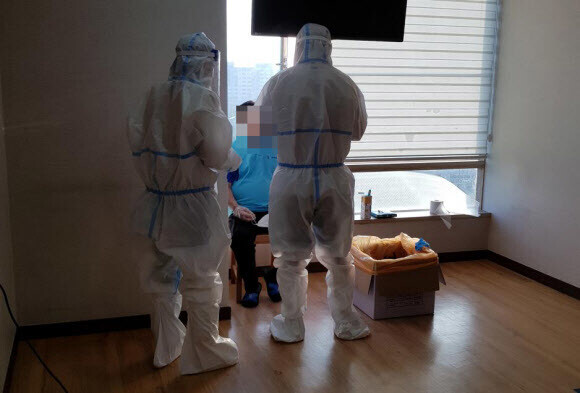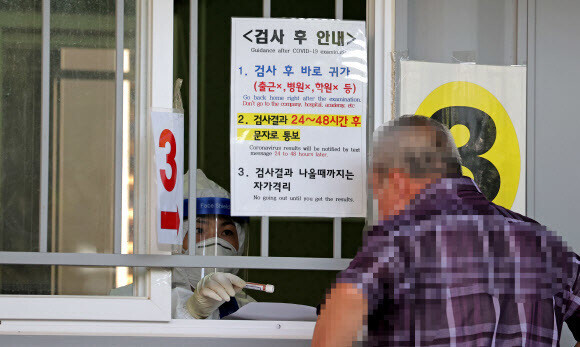hankyoreh
Links to other country sites 다른 나라 사이트 링크
[Reportage] A COVID-19 tragedy: dying patients can’t spend their last days with their families

“I didn’t even get to be with my mother on her deathbed, and I was shocked to see her body lying there behind a screen in the first-floor lobby of the nursing home.”
It’s heartrending for Shin, a 58-year-old living in Gwangju, to recall how her mother died. Her mother, surnamed Jang, passed away at a nursing home in Gwangju’s Buk (North) District on July 24, at the age of 84. Jang had spent seven months in the nursing home, where she’d been admitted in December 2019 after suffering from dementia for several years. Shin gets angry when she thinks of the nursing home’s practices shortly before her mother’s death.
At 11 pm on Aug. 23, the nursing home called Shin’s family to inform them that Jang’s condition had worsened and to get ready for a phone call, possibly in the early hours. After spending a sleepless night, Shin and her family members told nursing home staff at 10:25 the next morning that they wanted to be with their mother in her final hours, even if that meant buying personal protective equipment to wear. The staff promised to move Jang to a private end-of-life room that family members could enter one at a time when her situation became grave.
But in the end, Shin and her family didn’t get to accompany Jang in her final hours. At 12:02 pm that same day, the hospital called Shin, asking her to come to the hospital quickly; 12 minutes later, S got another call, informing her that her mother had died.
Wearing protective equipment, Shin entered the intensive care unit on the sixth floor and wept before the lifeless body of her mother. “They immediately took my mother’s body to the first floor and unceremoniously dumped her behind a screen near the bathroom. I realize we’re in a pandemic situation, but there was absolutely no respect for the deceased,” said S, who was Jang’s eldest daughter.
“We choose to set aside a two-person room where family members can have a final meeting with their loved ones. In the case of Jang, we contacted her family just as soon as her condition began to drastically deteriorate, but she passed away before her family could arrive. [Other nursing homes] send the body of the deceased to the funeral home as soon as the hearse arrives, but we give family members a final chance to see their loved one on the first floor,” said a spokesperson for the nursing home in question.
During the COVID-19 pandemic, being unable to say farewell to loved ones has become a sad part of our everyday lives. Now that the social distancing regimen has been upgraded to Level 2.5, people aren’t allowed to visit aging family members at hospitals or nursing homes, with the inevitable result that elderly people at such facilities are alone when they pass away. The rules are particularly strict for patients with COVID-19, who aren’t allowed to see family members even in their final hours and who are cremated immediately upon death. People aged 70 and above account for about 80% of the 300 or so people who have died of COVID-19 in Korea.

Demands for hospitals, nursing homes of certain size to have end-of-life rooms
That has prompted demands for measures that would allow people to meet death with a certain measure of dignity in the COVID-19 era. Back in June, Joo Ho-young, lawmaker with the United Future Party (UFP), submitted an amendment to the Medical Services Act that would have required nursing homes and general hospitals above a certain size to set aside end-of-life rooms where dying patients can spend their final hours with family members. Such privacy is needed since Koreans often share hospital rooms with multiple patients, with rooms housing as many as eight patients at a time. The bill was scrapped back in 2018 but was resubmitted amid growing interest about end-of-life rooms during the COVID-19 crisis.
According to documents provided by Ju’s office, 76.2% of deaths in South Korea in 2017 occurred in hospitals and other medical institutions. But only 17 out of 42 (40%) of Korea’s largest medical centers had end-of-life rooms. No data is available for how many nursing homes (1,587) and general hospitals (320) around the country have such rooms.
“It’s unfortunate that there aren’t many spaces set aside for people to spend their final hours with their family in dignity. We need to make it mandatory for medical facilities of a certain size to create end-of-life rooms,” said one of Ju’s staffers.
Currently, the Medical Service Act only requires hospice centers to have at least one end-of-life room. “[Korea’s 87] hospice centers, which care for terminal cancer patients and others in their final days, have end-of-life rooms, but there’s no legal requirements for general hospitals or nursing homes to do so,” said an official from the Ministry of Health and Welfare (MOHW).
When medical facilities lack end-of-life rooms, patients thought to be in grave condition are sometimes moved to the intensive care unit. But they sometimes pass away in multi-person hospital rooms, creating distress for the other patients and their family members.
End-of-life rooms in nursing homes require payments from national health insuranceNursing homes are asking for national health insurance to make payouts for the use of end-of-life rooms, since setting them up might well require repurposing a single-person hospital room. “We need to provide high-quality services and facilities, which would be possible if appropriate insurance payouts are made for the use of end-of-life rooms, as they are in Japan and Taiwan,” said Son Deok-hyeon, chair of the Korean Convalescent Hospital Association.
“Hospitals should be given the discretion to decide whether or not to set up an end-of-life room,” the Korean Hospital Association said.
“We need to find a way for COVID-19 patients in grave condition to see their family members, even if it’s outside their hospital room. Now that Korea is facing the COVID-19 crisis on top of societal aging, it’s time we found ways to ensure that people can die with dignity,” said Shin Min-ho, a professor of preventive medicine at Chonnam National University.
By Jung Dae-ha, Gwangju correspondent
Please direct comments or questions to [english@hani.co.kr]

Editorial・opinion
![[Column] Life on our Trisolaris [Column] Life on our Trisolaris](https://flexible.img.hani.co.kr/flexible/normal/500/300/imgdb/original/2024/0505/4817148682278544.jpg) [Column] Life on our Trisolaris
[Column] Life on our Trisolaris![[Editorial] Penalties for airing allegations against Korea’s first lady endanger free press [Editorial] Penalties for airing allegations against Korea’s first lady endanger free press](https://flexible.img.hani.co.kr/flexible/normal/500/300/imgdb/original/2024/0502/1817146398095106.jpg) [Editorial] Penalties for airing allegations against Korea’s first lady endanger free press
[Editorial] Penalties for airing allegations against Korea’s first lady endanger free press- [Editorial] Yoon must halt procurement of SM-3 interceptor missiles
- [Guest essay] Maybe Korea’s rapid population decline is an opportunity, not a crisis
- [Column] Can Yoon steer diplomacy with Russia, China back on track?
- [Column] Season 2 of special prosecutor probe may be coming to Korea soon
- [Column] Park Geun-hye déjà vu in Yoon Suk-yeol
- [Editorial] New weight of N. Korea’s nuclear threats makes dialogue all the more urgent
- [Guest essay] The real reason Korea’s new right wants to dub Rhee a founding father
- [Column] ‘Choson’: Is it time we start referring to N. Korea in its own terms?
Most viewed articles
- 160% of young Koreans see no need to have kids after marriage
- 2New sex-ed guidelines forbid teaching about homosexuality
- 3Presidential office warns of veto in response to opposition passing special counsel probe act
- 4Months and months of overdue wages are pushing migrant workers in Korea into debt
- 5[Guest essay] Maybe Korea’s rapid population decline is an opportunity, not a crisis
- 6OECD upgrades Korea’s growth forecast from 2.2% to 2.6%
- 7[Column] Life on our Trisolaris
- 8Bills for Itaewon crush inquiry, special counsel probe into Marine’s death pass National Assembly
- 9Full text of press communique released at new round of six-nation
- 10Gangnam murderer says he killed “because women have always ignored me”